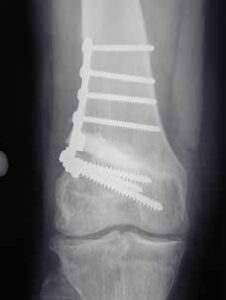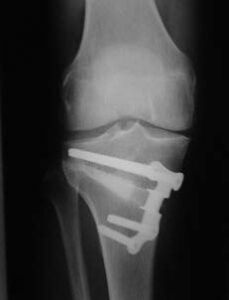An osteotomy is a surgical procedure used to address osteoarthritis of the knee, a condition characterised by the degeneration of articular cartilage in the knee joint. It involves cutting the tibia or femur bone and changing the overall alignment of the leg to take weight away from the part of the knee that is affected by osteoarthritis.
Osteoarthritis leads to the loss of the smooth, protective cartilage surface, resulting in pain, stiffness, and decreased mobility.
The knee joint comprises three compartments: the patellofemoral compartment between the patella(Knee cap) and femur, and the medial (inside) and lateral (outside) compartments between the tibia and femur.
Osteoarthritis may affect one or more of these compartments, causing localised damage. When the osteoarthritic process is isolated to either the medial or lateral compartment, an osteotomy may be recommended as a surgical option to alleviate significant symptoms.
The primary objective of an osteotomy is to alter the lower limb's alignment, redirecting weight-bearing forces away from the affected area towards healthier regions of the joint. By shifting the weight-bearing line, the aim is to alleviate symptoms, delay the need for joint replacement surgery, and potentially slow down the progression of osteoarthritis.
Osteotomies can be performed either above or below the knee joint, depending on the location of the affected compartment. For medial compartment osteoarthritis, surgery typically targets the upper tibia, while for lateral compartment osteoarthritis, the osteotomy is usually performed on the lower femur.
It is important to note that surgery will cause a noticeable change in the leg's appearance. Individuals with medial compartment osteoarthritis typically exhibit a bowlegged stance, and the osteotomy will result in the leg becoming slightly knock-kneed. Conversely, those with lateral compartment osteoarthritis tend to have a knock-kneed alignment before surgery, but following the procedure, the leg will become straight or slightly bow-legged.
During the procedure, the bone is cut completely, and two methods are employed to realign it. One method involves removing a wedge of bone, while the other entails making a cut and opening up a wedge, which may be filled with bone or a bone substitute. Metallic fixation devices, such as plates and screws, are often used to stabilise the bone during the healing process.
Typically, a drain tube is placed in the wound post-surgery to manage fluid accumulation. This tube is usually removed the morning following the procedure.
Osteotomy is typically performed under general anaesthesia, with most patients admitted on the day of surgery and staying in the hospital for 2 to 3 nights.


Osteotomy procedures, like all surgeries, carry inherent risks and potential complications that patients should be aware of:

After the osteotomy procedure, post-operative care is crucial to ensure optimal healing and rehabilitation:
This structured recovery and rehabilitation process aims to optimise healing, restore knee function, and enhance mobility, ultimately enabling you to resume your daily activities with improved joint health and functionality.
These notes from OrthoSport Victoria are for educational purposes only and are not to be used as medical advice. Please seek the advice of your specific surgeon or other health care provider with any questions regarding medical conditions and treatment.
If you are looking to book an appointment, please call us on